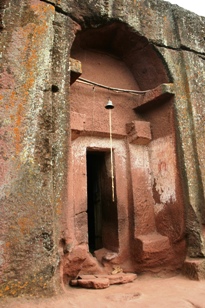
ROCK HEWN CHURCHES
Over
125 rock hewn churches are recorded with Tigray-alone. These churches date from
4th-15th century. Most of them are visited around the Gera-Alta chained mountains.
Others are found in eastern and southern Tigray. Abreha-We-Atsbeha, Wukro Chercko
churches are hewn in the 4th century. There are some pre Christian period hewn
templates too. Special programs can be arranged to visit the Tigray Rock Churches
either on surface or camping even up to 2-3 weeks. Otherwise a two or three days
addition to the classical route itineraries can be nice to pay a visit of these
churches.
Abraha
wa Atsbeha
The wonderful church of Abreha wa Atsebha is situated 15 kms.west
of Wuqro. A newly built gravel road leads to within a few meters of the church
and beyond to Hawzien via Degum.
The church is one of the best and largest
of the rock churches of Tigray, dedicated to the famous kings of Axum, the brothers
Abreha and Atsebha. They are known by that name to history, but they are said
in Ethiopian legends to be kings who adopted Christianity in the 4th century.
The historical king of Axum who did adopt Christianity around that time was king
Ezana . His name is equally unknown in Ethiopian legendary accounts.
The
church is cut into the red rock overlooking a valley, and stands out with its
white painted façade sheltering two tall blue doors under arches. The church
is decorated with splendid post-17th century mural paintings depicting Biblical
scenes and saints. It also has several valuable treasures, the most important
being the prayer cross which according to churchy officials, belonged to Frumentius-
the first Bishop of Ethiopia whose ecclesiastical name was Abba Salama (Father
of peace).
Wukro
Cherqos
Directly a the edge of the small town of Wuqro
(47 Kms from Mekele), on a knoll of red rock, is the rock- cut church of Wuqro
Cherqos.The church is supposed to have been constructed by the 4 C by the two
kings Abreha and Asbeha. It is one of the first of the rock churches of Tigray.
The upper part of the wool and the ceilings were painted, but now much destroyed.
Nevertheless, a good impression of the decoration can be gained. A number of scenes
can be distinguished: cherubim and angles, the Abune Samuel, the Nine Saints,
St. Qirqos. The priests tell the story that the church was burnet by Gudit, the
distinctive queen who is supposed also to have toppled the Axum stelae.


